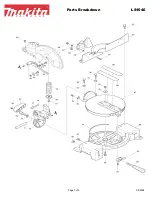
English |
17
Bosch Power Tools
1 609 92A 0SU | (21.11.14)
Declaration of Conformity
We declare under our sole responsibility that the product de-
scribed under “Technical Data” is in conformity with all rele-
vant provisions of the directives 2011/65/EU, 2014/30/EU,
2006/42/EC including their amendments and complies with
the following standards: EN 60745-1, EN 60745-2-5.
Technical file (2006/42/EC) at:
Robert Bosch GmbH, PT/ETM9,
70764 Leinfelden-Echterdingen, GERMANY
Robert Bosch GmbH, Power Tools Division
70764 Leinfelden-Echterdingen, GERMANY
Leinfelden, 03.11.2014
Assembly
Mounting/Replacing the Saw Blade
Before any work on the machine itself, pull the mains
plug.
When mounting the saw blade, wear protective gloves.
Danger of injury when touching the saw blade.
Only use saw blades that correspond with the charac-
teristic data given in the operating instructions.
Do not under any circumstances use grinding discs as
the cutting tool.
Selecting a Saw Blade
An overview of recommended saw blades can be found at the
end of this manual.
Removal of the Saw Blade (see figure A)
– Tilt back the retracting blade guard
11
and hold firmly.
– Lock the clamping flange
20
using an open-end spanner
24
(size 22 mm) or position the saw blade
21
onto a piece
of wood.
– With the Hex key
3
, unscrew the clamping bolt
23
turning
in rotation direction
.
– Remove the clamping flange
20
and the saw blade
21
from
the saw spindle
19
.
Mounting the Saw Blade (see figure A)
– Clean the saw blade
21
and all clamping parts to be assem-
bled.
– Tilt back the retracting blade guard
11
and hold firmly.
– Place the saw blade
21
on to the mounting flange
22
. The
cutting direction of the teeth (direction or arrow on saw
blade) and the direction-of-rotation arrow on the blade
guard
16
must correspond.
– Mount the clamping flange
20
and screw in the clamping
bolt
23
turning in rotation direction
. Observe correct
mounting position of mounting flange
22
and clamping
flange
20
.
– Lock the clamping flange
20
using an open-end spanner
24
(size 22 mm) or position the saw blade
21
onto a piece
of wood.
– With the Hex key
3
, tighten the clamping bolt
23
turning in
rotation direction
. The tightening torque is between
6–9 Nm, which corresponds to hand tight plus ¼ turn.
Adjusting the Riving Knife (see figure B)
Before any work on the machine itself, pull the mains
plug.
Always work with the riving knife, except when carry-
ing out plunge cuts.
The riving knife prevents jamming of
the saw blade while sawing.
Adjustment is carried out at maximum cutting depth, see Sec-
tion “Adjusting the Cutting Depth”.
Loosen screw
25
, adjust the riving knife
12
to the measure
shown in the figure and tighten screw
25
with a tightening
torque between 3.5–5 Nm.
Dust/Chip Extraction
Before any work on the machine itself, pull the mains
plug.
Dusts from materials such as lead-containing coatings,
some wood types, minerals and metal can be harmful to
one’s health. Touching or breathing-in the dusts can cause
allergic reactions and/or lead to respiratory infections of
the user or bystanders.
Certain dusts, such as oak or beech dust, are considered
as carcinogenic, especially in connection with wood-treat-
ment additives (chromate, wood preservative). Materials
containing asbestos may only be worked by specialists.
– As far as possible, use a dust extraction system suitable
for the material.
– Provide for good ventilation of the working place.
– It is recommended to wear a P2 filter-class respirator.
Observe the relevant regulations in your country for the mate-
rials to be worked.
Prevent dust accumulation at the workplace.
Dusts can
easily ignite.
External Dust Extraction
Mount the vacuum hose
30
(accessory) on to the chip ejector
17
. Connect the vacuum hose
30
to a vacuum cleaner (acces-
sory). An overview for connecting to various vacuum cleaners
can be found at the end of this manual.
The machine can be plugged directly into the receptacle of a
Bosch all-purpose vacuum cleaner with remote starting con-
trol. The vacuum cleaner starts automatically when the ma-
chine is switched on.
The vacuum cleaner must be suitable for the material being
worked.
When vacuuming dry dust that is especially detrimental to
health or carcinogenic, use a special vacuum cleaner.
Integrated Dust Extraction with Dust Bag
For smaller jobs, a dust bag (accessory) can be mounted. In-
sert the dust bag sleeve firmly into the saw dust ejector
17
.
Empty the dust bag at regular intervals to maintain optimum
dust collection.
Henk Becker
Executive Vice President
Engineering
Helmut Heinzelmann
Head of Product Certification
PT/ETM9
OBJ_BUCH-179-005.book Page 17 Friday, November 21, 2014 10:07 AM
















































